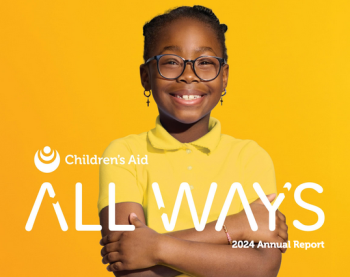Testimony of Katherine Eckstein, Director of Public Policy, The Children’s Aid Society Prepared for the NY Education Reform Commission Public Hearing, New York City October 16, 2012
My name is Katherine Eckstein and I am the Director of Public Policy at The Children’s Aid Society (CAS). I’d like to thank The Governor for forming this incredibly timely and important Commission and Chair Parsons and other members of the Commission for the opportunity to submit testimony regarding efficient, effective and actionable solutions to improve New York’s public education system in order to better meet the needs of its students – the future of this State.
As one of the nation’s largest and oldest community-based organizations, The Children’s Aid Society (CAS) helps children in poverty to succeed and thrive. We do this by providing comprehensive supports to children and their families in targeted high-needs New York City neighborhoods. Today, CAS touches the lives of more than 70,000 children and families each year. Our network of community centers, community schools, and health clinics is organized into service hubs concentrated in the South Bronx, Harlem, Washington Heights and Northern Staten Island. Citywide we offer more than 100 programs in 45 sites with services that span cradle through college graduation. We provide: education and youth development services, foster care and preventive services, expanded learning opportunities (after-school, weekend and summer enrichment), early childhood programs, teen pregnancy prevention, comprehensive health services (including medical, mental health and dental), legal services, and programs for disconnected youth, including programs for young people who have been incarcerated or are at high risk of incarceration.
All of us know too well the reality that students, schools, districts and communities face. We are not supporting NYS children with the tools they need to be ready for college and career. I will not delve into the statistics that we already know, however I will share briefly our experience working with children and their families because we believe it must inform policy moving forward. Every day, we see the cruel and unrelenting impact of the current economic reality on the children and families that we exist to serve. Families that are already struggling face additional and compounding challenges in housing, employment, health, and other vital services. Over the past three years, demand for our programs and services has increased and families depend on us for childcare and early childhood programs, after-school programs, health services, preventive and child welfare services, summer jobs and direct assistance. One in three children in New York City, and two in three public school children, live in poverty. This necessarily impacts how children engage with school.
We know that at the end of the day a quality education and graduation from college are the most consistently reliable ways for kids to break free from poverty. This is why we’re pleased to see the Commission focusing on improving outcomes in high-need, low wealth communities. Today I will focus on the area outlined by the Commission as: Student Achievement and Family Engagement.
Accountability and Data: Adding Chronic Absenteeism as a Critical Data Point
As the State builds its longitudinal data system and explores more deeply how to most effectively evaluate and support schools, we encourage the State to include additional data points that can drive critical and timely decisions at schools. One of these data points is chronic absenteeism. Only measuring average daily attendance can mask large numbers of children missing significant numbers of days of school. Chronic absenteeism and low achievement are highly correlated. Yet until recently, chronic absenteeism data were not captured in New York City and they are still not captured in many parts of New York State, nor were they connected to data on individual student achievement. Attendance results for schools were reported only in the aggregate, masking individual students’ chronic absenteeism in schools with an overall acceptable attendance rate. Why does this matter? Simply: if children aren’t in school, they can’t learn.
Let’s take NYC as an example – in NYC, 90,000 elementary school students missed a month or more of school in each of the two school years from 2007-9.i This statistic was brought to light in an October 2008 report by the Center for New York City Affairs (CNYCA) – they are working on a follow-up report now.
Chronic absenteeism has a cumulative and cyclical effect, hindering children’s short- and long-term educational success. Causes of poor attendance include school, family and community related issues such as chronic health problems, housing instability, lack of parent engagement, an unsafe school environment and ineffective teaching.ii As a result, students miss critical academic work that makes it difficult for them to catch up. Nationally, among poor children, chronic absence in Kindergarten predicts the lowest levels of reading and math among fifth graders.iii Three out of four students who are severely chronically absent in the sixth grade never graduate from high school. Chronic absence is a predictor for involvement in the criminal justice system. In NYC, over 80% of children in the juvenile justice system had missed a month or more of school.iv Chronic absenteeism is a reliable, additional criterion to identify persistently low-performing schools, and provides a measure independent of test score data.
The proportionally inverse relationship between chronic absenteeism and academic performance is striking; as chronic absenteeism rises, academic performance declines. In NYC schools with less than 10% chronic absenteeism, 82% of students were proficient in ELA and 94% were proficient in math in 2008; on the other end of the spectrum, in schools with more than 50% chronic absenteeism, only 28% of students were proficient in ELA and 57% in math. Schools with more than 30% chronic absenteeism had a citywide math and ELA percentile ranking of 29 versus a rank of 85 for schools with less than 10% chronic absenteeism.
RECOMMENDATION: The State should, at a minimum, go beyond the existing reporting requirement of Average Daily Attendance (ADA) and require districts to calculate and report chronic absenteeism. The Children’s Aid Society has worked closely with Mayor Bloomberg’s Task Force on Chronic Absenteeism and we are eager to work with New York State to implement this recommendation.
Comprehensive Strategies for School Reform
Once we know which children are missing school consistently, how do we address the barriers that are preventing them from coming to school and the other barriers to learning that so many children face across New York State?
It is critical to ensure children are attending and connected to school by reducing the non-academic barriers to learning through coordinating and integrating student and family support services into the school. This includes: targeted interventions based on needs/asset assessments; expanded learning opportunities to increase time on task (before and after school and during the summer) that are aligned with the school curriculum and the Common Core; medical and mental health services; parent engagement/education programs; and direct support for families in crisis. All of these interventions address direct causes of why children do not attend or engage in school. These types of schools go by many names – community schools, full-service schools, wrap-around schools – but the core strategy is the same: they organize and align the human and financial resources of the education and human services sectors around student success.
Community schools are not formulaic and community schools are not a program. Instead they are a strategic response to the specific needs of the children in a particular school and an organizing framework to coordinate and integrate existing and new resources. Principals and teachers tell us that schools can’t do it alone. Organizing and mobilizing existing and new resources around schools through partnerships can help to address the dire situations that too many of our young people and their families face and that impact how successful a child will be in school.
Our schools offer mental health, medical and dental services. We enroll children in health insurance. Our schools provide high quality, enriching expanded learning opportunities after-school, holidays and summer that build upon what happens during the school day. Our schools offer classes for parents that might include learning English or starting a business and our schools hold immigration clinics for the neighborhood. Three of our schools have 0-5 early childhood programs on site. These programmatic components are not random acts of programming; instead they exist in schools in response to identified needs. In every one of our schools is a Community Schools Director, who works in close partnership with the principal and whose responsibility it is to integrate, align and target services and programs. All of these services and opportunities cannot replace an ineffective academic program, however when partnered with visionary leadership, strong teachers, a rigorous curriculum and high expectations, these schools give every child every chance to succeed.
Community schools are producing powerful results. We have commissioned a variety of independent evaluations of community schools we operate in partnership with the New York City Department of Education. These schools have consistently shown positive results around academic achievement, student and teacher attendance, parental engagement, positive school climate, and school safety. And analyses of community school evaluations from around the country have documented similar results.vi
We support SED’s plan in its ESEA waiver that “Priority Schools will be required to implement a systematic whole school reform model, which can be based upon a Full Service School model with wrap-around social and health services.” In addition, we support SED’s requirement that LEAs must partner with organizations to launch one of its six design frameworks, including a Full-Service (wrap-around services) Design.
Many districts around the country – from Tulsa to Chicago; from Oakland to Salt Lake City; and from Grand Rapids to Cincinnati have developed whole district community school (or Full-Service School) strategies. New York State has the opportunity to provide leadership and help build the capacity of districts across the State to do this work.
I’d like to make one note about parent engagement. Full-service schools engage parents and families because they know that children are a part of families and children will be more likely to succeed if their parent/caregiver is engaged in their education.
RECOMMENDATION: Because high-need, low wealth districts grapple with many similar poverty-related barriers to learning, all high need districts in New York State should adapt the full-service schools strategy. We have found that when districts, rather than individual schools, adapt the strategy, data and resources can be leveraged in a much more strategic and impactful way. A district-wide strategy requires cross-system work and has the potential to have collective impact on the 1,492,813 children in NYS (56% of all students) who attend school in a high-need district.
Thank you for the opportunity to testify today. The Children’s Aid Society is your partner as you develop an action plan to significantly improve outcomes for New York’s children.
__
i Nauer, K., White, A., &Yerneni, R. (2008). “Strengthening Schools by Strengthening Families: Community Strategies to Reverse Chronic Absenteeism in the Early Grades and Improve Supports for Children and Families,” Center for New York City Affairs, Milano The New School, October 2008.
ii Unemployment Report, NWREL. (2004). “Increasing Student Attendance: Strategies from Research and Practice.” Portland, OR: Education Northwest.
iii Chang, H., Romero, M. (2008). Present, Engaged, and Accounted for: The Critical Importance of Addressing Chronic Absence in the Early Grades. September 2008. National Center for Children in Poverty, Mailman School of Public Health, Columbia University.
iv NYC Office of the Mayor. (2011). Press Release: Mayor Bloomberg and New York Yankees Announce Partnership to Combat Truancy and Chronic Absenteeism for NYC Public Schools. Retrieved from http://www.nyc.gov/portal/site/nycgov/menuitem.c0935b9a57bb4ef3daf2f1c701c789a0/index.jsp?pageID=mayor_press_release&catID=1194&doc_name=http%3A%2F%2Fwww.nyc.gov%2Fhtml%2Fom%2Fhtml%2F2011a%2Fpr211-11.html&cc=unused1978&rc=1194&ndi=1
v CAS National Center for Community Schools http://www.childrensaidsociety.org/files/upload-docs/NCCS_Building%20Community%20Schools.pdf(28)
vi Coalition for Community Schools http://www.communityschools.org/assets/1/AssetManager/CCS%20Research%20Report2009.pdf



